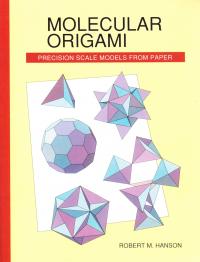Molecular Origami
Molecular Origami
By: Robert M. Hanson
Drawing on the Japanese art of paperfolding, the book provides rip-out patterns for 124 molecules, along with easy instructions for folding them into scale models, many of which are three-dimensional. This is a fun, hands-on guide to understanding the basic structure and chemistry of matter.
For all sales outside of the United States, please contact Felicity Henson, fhenson@aip.org
Title information
This is a fun, hands-on guide to understanding the basic structure and chemistry of matter. Drawing on the Japanese art of paperfolding, the book provides rip-out patterns for 124 molecules, along with easy instructions for folding them into scale models, many of which are three-dimensional. The molecules progress from simple ones like methane to more exotic structures such as quartz and buckminsterfullerenes. Questions and discussions are included.
Introduction
Part 1: Basic Shapes, Basic Ideas
Part 2: Advanced Shapes
Part 3: Beyond Octahedra
Part 4: More Complex Molecules and Ions
Part 5: Network Solids
Part 6: One- and Two-Dimensional Shapes
Discussion of Questions in Part 1
Sources and Methods
Index
|
“Useful in teaching chemical bonding concepts not only in high school and freshman chemistry classes, but also in undergraduate inorganic chemistry.” “This unusual, useful, and enlightening volume is clearly a labor of love. It offers students and science teachers a unique, entertaining, hands-on approach to stereochemistry and makes an ideal gift for budding scientists.” “Each pattern comes complete with chemistry questions to set students thinking…If you’ve never puzzled over the shape of a dodecaborane, you will now.” “Even the most uncoordinated klutz can assemble some of the simpler folded models, and — believe it or not — a few models (of linear and diatomic molecules) don’t require folding!…Molecules are beautiful. A lot can be learned by making and examing models of them. At least one student and teacher recommend Molecular Origami to other students and teachers.” “Students will come to really understand bonding and stereochemistry while they are having fun…a unique approach!” “This book is a must for every high school chemistry classroom!” |

